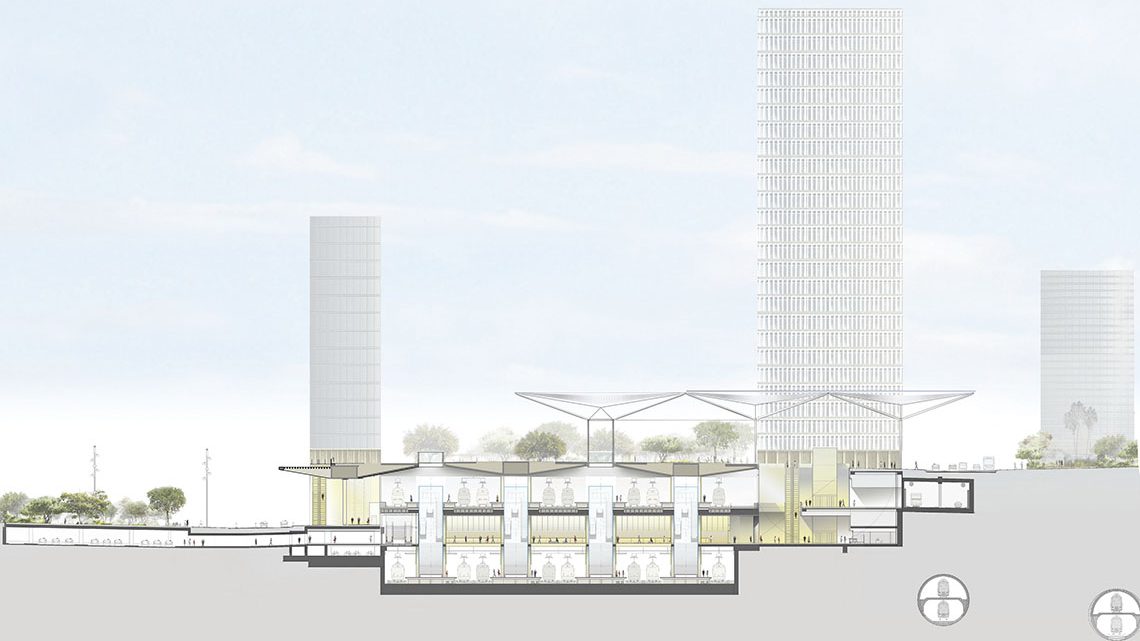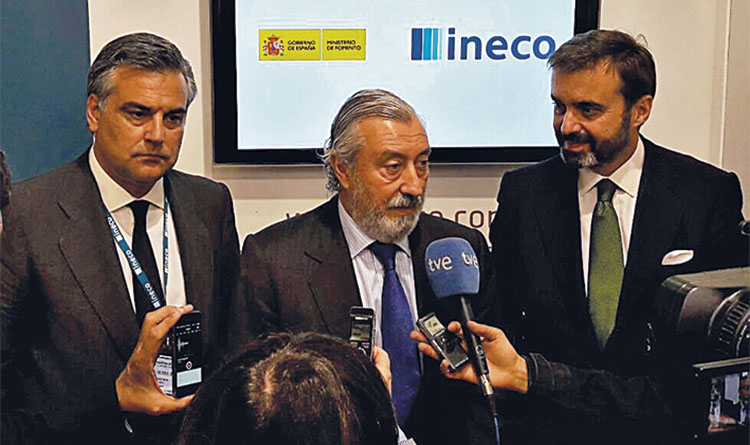The railway, in its endeavour to facilitate public transportation, has been opening new stations in cities in order to connect them to the world. Since the days of coal, travellers arriving at stations have discovered the atmosphere of a place through the introduction provided by the platforms, marquees, halls and restaurants of the major stations. This is how it was and still is: the entrance to a great station is also the entrance to the city, making it the duty of stations to bid travellers a friendly welcome and farewell, offering convenience and positive memories that enhance the reputation of the location.
A great station cannot be separate from the urban fabric that surrounds it. A station is a city, as are its entrances and its railway yard, which have a decisive impact on the character of the neighbourhood to which it belongs and on the layout of the roads.
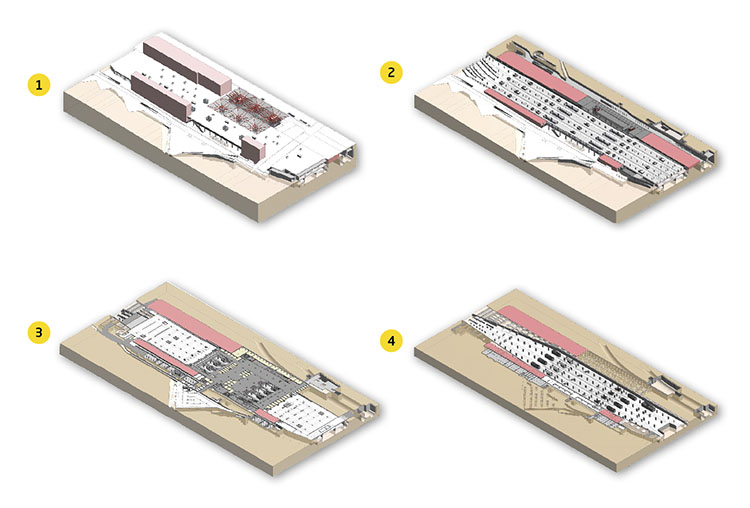
1. View of the roof 2. Platforms for high-speed services 3. Floor of the general hall 4. Platforms for Rodalies de Catalunya and regional train services. / INFOGRAPHIC_BSAV
A great railway station is also the main node that must make possible, in an orderly and efficient way, the routes that enable the mobility of the population. The need to travel must be satisfied by making an effort to minimise the external costs that transport entails, seeking formulas that are increasingly conscious of respecting the environment. The successful combination of different modes of transport in a single journey, taking advantage of the strengths of each one, has made multimodality a solution to be taken into account by regional planners, and it is in the design of large stations that this concept is of key importance.
Main node, city and gateway. The new intermodal station of La Sagrera, located in the Barcelona neighbourhood of the same name, aspires to all this
Main node, city and gateway. The new La Sagrera intermodal station, located in a neighbourhood in Barcelona bearing the same name, aspires to all these objectives. This aspiration is fully justified by the need to complement the existing node of Sants station and by the vocation to finish building a part of the city of Barcelona that over time had become a border separating two neighbourhoods: La Sagrera and Sant Martí de Provençals.
Sants station node, in operation since the 1970s, was adapted in 2008 to host Barcelona’s high-speed services. The station, which had 12 tracks with platforms, was expanded to 14 tracks, leaving 8 in Iberian gauge for conventional services and 6 in international gauge for high-speed services. There is no escaping the fact that practically all the commuter and regional service lines pass through this station, which is connected to two underground lines and is centrally located in the city, almost equidistant from the two arteries that cross Barcelona: Gran Via and Diagonal.
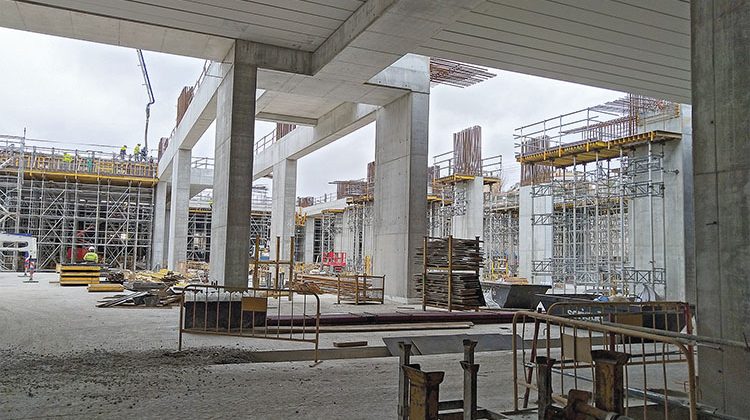
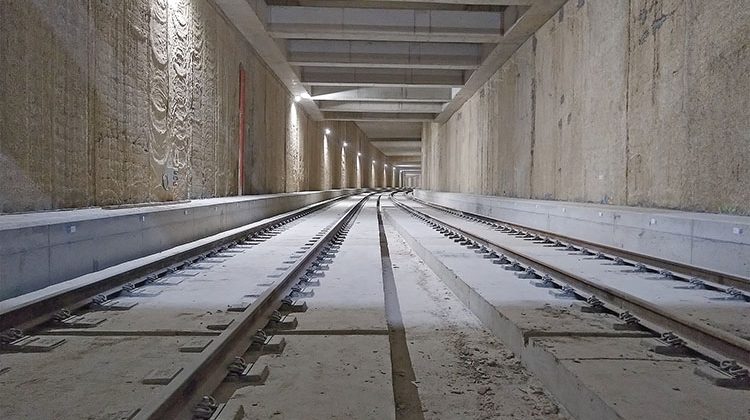
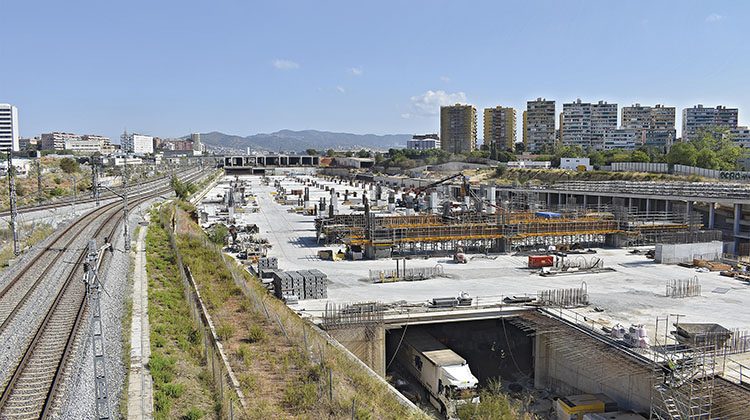
The conversion of long-distance intercity services, as well as some regional services, into high-speed services has gradually taken up the capacity offered by Sants station for this type of service. The Madrid-Barcelona high-speed corridor, which went into operation in 2008, was joined by the connection with France in 2013 and the link with the Mediterranean Corridor in 2020, generating a notable increase in demand for the use of the six international-gauge tracks at this station, as well as its associated workshop in the Can Tunis area.
Certainly, the possibilities offered by powerful infrastructure such as the Madrid-Barcelona-French border high-speed line invite us to think about future growth. The fight against climate change calls for the promotion of railways in the internal relations between the Member States of the European Union, especially on those corridors where the railway guarantees reliable service that takes less than three hours between city centres, thereby making it possible to only use aviation for longer connections to take advantage of its strengths. Initiatives in the high-speed rail sector have been developed to respond to this situation, ranging from the use of higher capacity trains (dual-composition trains or double-decker units, for example) to low-cost services or, in another sense, preferential services with open tickets that emulate those offered by some airlines; all of these initiatives will strengthen the amortisation and raison d’être of the infrastructure built in recent decades. Be that as it may, anticipating that demand for mobility will not slow down (on the contrary, it seems that it will continue to grow, once the ravages of the pandemic have been overcome), the high-speed services that will reach Barcelona in the coming years are going to need a greater number of tracks on which to hold trains, on which to park them (during off-peak hours and after business hours), and on which to maintain and repair them.
The fight against climate change and the liberalisation of the railways, among other circumstances, make it necessary for Barcelona to have a new high-speed station
In addition to these circumstances, the process of railway liberalisation already that is under way, sponsored by the European Union, should be added to the list in order to create a more efficient system capable of achieving the best possible transport supply. The high-speed infrastructure must be prepared for a multi-operator scenario, where tracks with platforms and auxiliary track and workshop facilities are no longer used by a single incumbent operator, but must be shared or distributed among different railway operators.
All of this makes it absolutely essential for Barcelona to have a new station and parking tracks for high-speed services. It is, in short, the fundamental purpose of La Sagrera station. Its location is not as central as that of Sants station, but it will not be at a disadvantage. On the contrary, both stations will complement each other: if Sants station, due to its central position in the urban fabric of Barcelona, will play a key role for users of high-speed services who live in a large part of the city and its nearby metropolitan area, La Sagrera station, given its good connections to the highway network, will be provide an advantage for those coming from the metropolitan region and beyond.
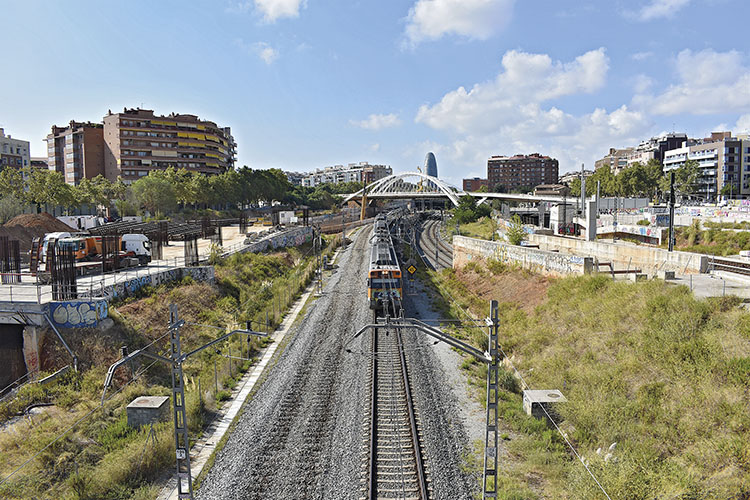
The two lines of the Rodalies network running through La Sagrera. / PHOTO_LUIS UBALDE
In addition to the six international-gauge tracks currently housed at Sants station, eight tracks with their four respective platforms will be added in La Sagrera station. The station building will contain, in addition to the commercial platform area, a technical train management area equipped with ten parking tracks with their corresponding technical platforms (apart from the two general passing tracks) where preparatory operations can be carried out for a new service for those trains that have La Sagrera as their station of origin. This involves cleaning operations, emptying WCs and supplying them with bactericidal liquid and water, changing the position of the seats and replenishing food supplies. These operations, which in part are being carried out in the existing stations on the commercial platforms themselves, will have two completely separate spaces in La Sagrera, increasing operational capacity and safety. Considering that the platforms for high-speed services must allow trains of up to 400 metres in length to be parked, a building is being built in La Sagrera that is almost a kilometre long, which includes the commercial platform area, the technical platform area and an intermediate space where the track devices that connect the parking tracks with the sidings are located.
The track layout was designed so that the station serves both trains that use La Sagrera as an intermediate station and those coming from south of Barcelona that end their journeys at this station. To do this, it was decided that the general tracks would be the ones outside the station’s train yard, leaving the sidings in the central area, so that train rotation can take place without any shear stress at the station’s head. Excluding the general tracks, the remaining six tracks of the commercial platform area are related to the parking tracks of the technical train management area as follows: each pair of parking tracks is assigned three siding tracks, leaving one extra parking track.
This new urban area will have a particularly environmentally sensitive design that optimises energy efficiency and supply and waste management
In addition to the two areas described (commercial platform area and technical train management area) there is a third area, which, though not connected to the previous areas, is very close to them. This is a workshop area with reception and working tracks equipped with pits, directly connected to the tracks in the technical train management area, without having to occupy the main track to go from one area to another.
The intermodal nature of La Sagrera node makes this facility a station of stations. In fact, in addition to everything that has been said about high-speed services, there is also a section devoted to commuter and regional train services on two lines of the conventional network: the line from Barcelona to Mataró and the line from Barcelona to Granollers, which continues to Girona and Portbou. In addition, the station is complemented by an underground intercity bus station and the connection with two lines of the Barcelona underground network (lines L4 and L9/L10). All of this is organised into a structure formed by three main levels: on the lower level of the station, the tracks of the conventional network (four tracks of the Barcelona-Mataró line and four tracks of the Barcelona-Granollers line with their respective platforms); on the intermediate level, the station hall (with a part for commuter users; another part for high-speed users) and on both sides of the hall, a parking area for cars; and lastly, on the upper level, the international-gauge tracks and their platforms for high-speed services.
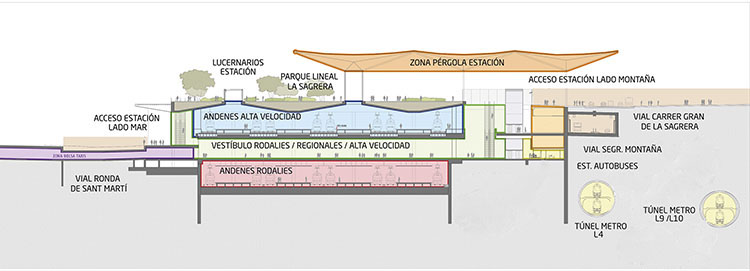
CROSS SECTION OF THE STATION. The design of La Sagrera intermodal station facilitates transfers between different modes of transport. / IMAGE_ADIF ALTA VELOCIDAD AND BSAV
Currently, the execution of the works is at the point where, having completed the curtain walls that surround the lower level of the station, the floor slab (2.5 metres thick) and having finished the first slab, the line from Barcelona to Mataró has been put into service inside the station structure and its accesses. Of course, trains have not yet started to pick up and drop off passengers, but merely passing through the heart of the future station undoubtedly represents a major milestone. Subsequently, a similar procedure will be followed for the line from Barcelona to Granollers, and lastly, the high-speed line will move from its current provisional alignment to its definitive location inside the station.
The work on La Sagrera station goes beyond what has been described here: its scope goes as far as constructing a piece of Barcelona. The station is also a part of the city. It is located on a railway corridor along which three railway lines run, which will no longer be above ground and will be covered by a city park. With its 40 hectares, this will be the largest urban park in the city, running above the train tracks over a distance of 3.7 kilometres. Its construction is associated with the urban development of the old railway area of La Sagrera, which, from the generation of 1.25 million m2 of buildable roof, will mean the creation of housing for 25,000 inhabitants at the end of the whole process (more than 40%, will be protected housing), as well as generating some 30,000 jobs throughout the area.
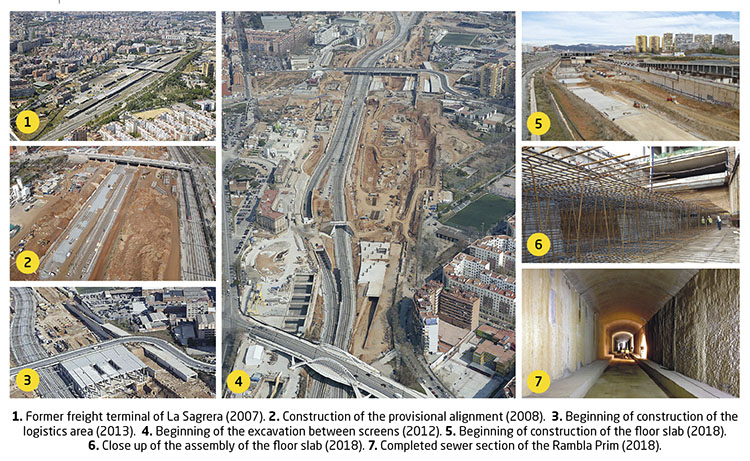
THE EVOLUTION OF THE WORK IN PICTURES. / PHOTOS_ADIF ALTA VELOCIDAD
This new urban area will have a particularly environmentally sensitive design that optimises energy efficiency and supply and waste management. In this respect, groundwater will be used for the irrigation system for the landscaped areas and the sewer tanks of the tertiary buildings; there are also plans to implement a centralised air-conditioning system, which will use the waste heat from an existing incineration plant in cold weather and will provide cooling by using sea water; the buildings will have pneumatic waste collection and will be connected to a state-of-the-art telecommunications network, all in accordance with the criteria of a truly smart city.
As a result of all this, a new gateway is being built in Barcelona, La Sagrera station, and this gateway will serve not only those who enter and leave the city, but also introduce more efficient, attractive and sustainable form of mobility, based on multimodality. Given the urgency of the situation, we cannot falter in our fight against climate change: this work is a step in the right direction.


